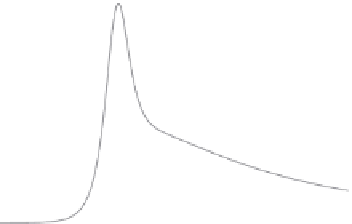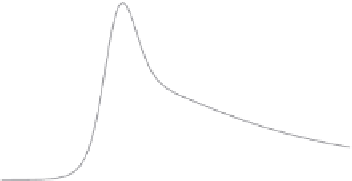Biomedical Engineering Reference
In-Depth Information
TABLE 17.1
Properties for Some Potential Magnetic Nanoparticle
and often follow log-normal distributions with (
r
0
,σ). he efec-
tive polydisperse SAR can be solved for by integrating across the
probability distribution function, as shown in Equation 17.15.
The general effects of polydispersity are illustrated for magnetite
in Figure 17.4. It is clear that polydispersity significantly flattens
the peak, but this broadening will also reduce the sensitivity to
small shifts in the mean size.
Materials
M
S
(kA/m)
K
u
(kJ/m
3
)
c
p
(J/kg-K)
ρ
(kg/m
3
)
Material
Magnetite
a
446
23
670
5180
Maghemite
a
414
4.7
746
4600
Iron
b
1707
48
450
7870
Iron-Cobalt
c
1815
15
172
8031
2
FCC Iron-Platinum
d
1140
206
327
15,200
R
r
ln
∞
0
1
2
a
Values taken from Rosensweig (2002)
b
Values taken from O'Handley (2000)
c
Values taken from Kline et al. (2009)
d
Values taken from Maenosono and Saita (2006)
0
SAR AR rgrdrg
=
() ()
gR
()
=
σ
exp
−
.
,
2
R
π
2
σ
(17.15)
included in Table 17.1. Bulk heat capacity (
c
p
) and density (ρ) have
also been included, as these are important for subsequent heating
calculations. Characteristic size-dependent heating curves for iron
oxide (magnetite and maghemite) are also illustrated in Figure
17.4. Location of the peak is largely dependent on the material
anisotropy, but will also vary slightly based on the frequency, vis-
cosity, and temperature. Amplitude of the peak depends strongly
on the material magnetization, and so larger moment materials
will produce higher rates of heating (all other factors equal). Puri
et al. completed a theoretical analysis, comparing the heating
capabilities of some potential magnetic materials in a spherical,
perfused tissue system (Kappiyoor et al. 2010). The results sug-
gested that barium-ferrite and cobalt-ferrite would not be able to
produce sufficient heating at physiologically relevant concentra-
tions and field parameters, but magnetite, maghemite, and FCC
iron-platinum demonstrated adequate SARs for treatment. The
authors also suggested the rate of heating for iron-cobalt was too
high for safe application. However, treatment could be applied at
lower nanoparticle concentrations or lower fields, and it is more
likely that the potential cytoxic effects of cobalt will be a larger
hurdle to safe application in vivo.
In addition, the strong size dependence indicates that poly-
dispersity will be an important consideration. Most magnetic
nanoparticle populations demonstrate significant polydispersity
The magnetic field parameters are another important factor
in determining heating effects. Referring back to Equation 17.10,
volumetric power generation depends directly on the applied
frequency and square of the applied field strength. However,
field effects on susceptibility also need to be taken into account.
Figure 17.5 illustrates the effects of applied frequency and field
strength on susceptibility and SAR for magnetite. Susceptibility
(χ
''
) reaches a slight peak for a frequency
f
= 250 kHz and demon-
strates a linear decrease for increasing field strength. The power
generation is roughly linearly dependent on both frequency and
field strength, within the usable field parameters. Frequency
effects will approach a plateau for frequencies on the order of
several MHz, but again, other unintended heating effects will
dominate in these ranges, limiting clinical use for MFH, so this
is generally of no consequence.
Brownian heating will also increase significantly in cases of
very low fluid viscosity. However, this is not generally relevant in
biological cases, where the particle is in aqueous suspension, but
could have an impact for loosely attached coatings or particles in
a multifunctional polymer matrix. In contrast, Brownian heat-
ing can be effectively eliminated if particles are bound to bio-
logical structures or form aggregates with large hydrodynamic
diameters. Temperature also appears in a number of the equa-
tions and will have minor effects on both magnetic properties
0.4
0.35
0.3
0.25
0.2
0.15
0.25
σ
= 0
Magnetite
Maghemite
0.2
σ
= 0.05
0.15
σ
= 0.10
σ
= 0.15
0.1
σ
= 0.25
0.1
0.05
0
0.05
0
3
5
7
9
11
13
15
3
5
7 9
Mean core radius (nm)
11
13 15
(a)
(b)
Core radius (nm)
FIGURE 17.4
Size-dependent heating comparison for magnetite/maghemite (a) and polydisperse magnetite (b) in water. Field at 10 kA/m and
250 kHz.
























